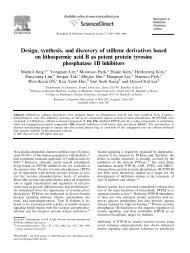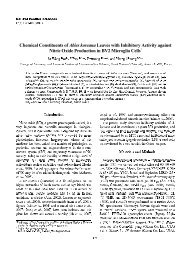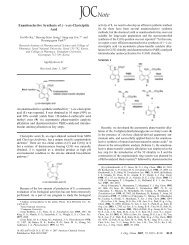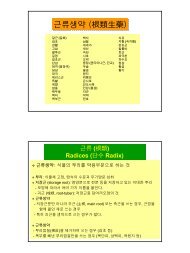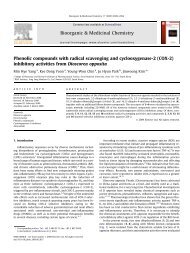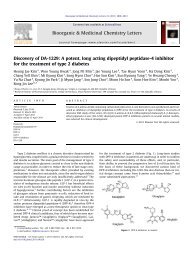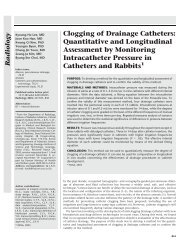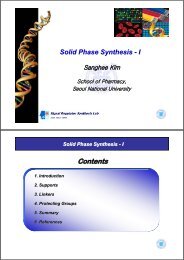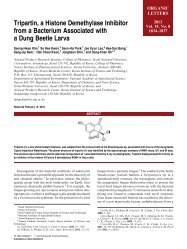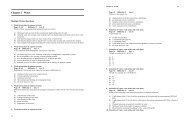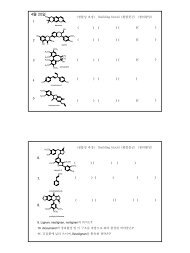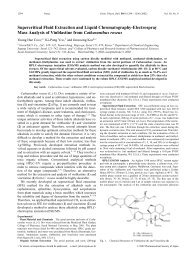Transport of anti-allergic drugs across the passage cultured human ...
Transport of anti-allergic drugs across the passage cultured human ...
Transport of anti-allergic drugs across the passage cultured human ...
You also want an ePaper? Increase the reach of your titles
YUMPU automatically turns print PDFs into web optimized ePapers that Google loves.
204 H. Lin et al. / European Journal <strong>of</strong> Pharmaceutical Sciences 26 (2005) 203–210drug transport and absorption. Fur<strong>the</strong>rmore, primary culture<strong>of</strong> nasal epi<strong>the</strong>lial cells from a variety <strong>of</strong> species including<strong>human</strong>, bovine, rat, and rabbit can provide valuable invitro models in <strong>the</strong> study <strong>of</strong> nasal physiology. The culture<strong>of</strong> cells and tissue derived from differentiated <strong>human</strong> nasalepi<strong>the</strong>lium is an established tool for <strong>the</strong> studies <strong>of</strong> fibrosis,electrolyte transport, ciliogenesis, and ciliary movement(Ruckes et al., 1997; Jorissen and Bessems, 1995). In vitrocell culture models <strong>of</strong>fer many advantages, including: (a) acontrolled environment for <strong>the</strong> study <strong>of</strong> epi<strong>the</strong>lial cell growthand differentiation; (b) <strong>the</strong> elucidation <strong>of</strong> drug transport pathwaysand mechanisms; (c) rapid and convenient means <strong>of</strong>evaluating drug permeability; (d) opportunity to minimize <strong>the</strong>expensive and limited controversial use <strong>of</strong> animals (Schmidtet al., 1998). It has been reported that <strong>human</strong> nasal primarycultures as in vitro models show <strong>the</strong> potentials for <strong>the</strong> study<strong>of</strong> nasal drug absorption, especially for <strong>the</strong> peptide transportstudies (Werner and Kissel, 1995; Kissel and Werner, 1998;Agu et al., 2001).However, efforts to develop and characterize nasal cellculture systems for drug metabolism and permeation arestill in <strong>the</strong>ir infancy. The main limitation is <strong>the</strong> difficulty inobtaining a reliable tissue source, which hinders <strong>the</strong> usefulness<strong>of</strong> in vitro cell culture model especially if <strong>human</strong> tissueis preferred. In order to overcome <strong>the</strong> shortage <strong>of</strong> <strong>human</strong>nasal tissue, researchers have shifted from primary cultures<strong>of</strong> epi<strong>the</strong>lial cells to <strong>passage</strong> <strong>cultured</strong> cell lines. Transformation<strong>of</strong> <strong>human</strong> nasal polyp cells using a chimaeric virus(Ad5/SV40 1613 ori-) is one <strong>of</strong> <strong>the</strong> examples <strong>of</strong> <strong>the</strong> change intrends. The extended lifespans ranged from 20 to more than250 population doublings beyond that <strong>of</strong> <strong>the</strong> primary cultures(Buchanan et al., 1990). In a previous report, we have established<strong>the</strong> <strong>passage</strong>d <strong>human</strong> nasal epi<strong>the</strong>lial culture method for<strong>the</strong> drug transport studies (Yoo et al., 2003), where <strong>the</strong> LCCmethod was utilized and properties <strong>of</strong> nasal epi<strong>the</strong>lium wereinvestigated by bioelectric and morphological studies. Thecharacteristic high TEER value, which was an indication <strong>of</strong><strong>the</strong> formation <strong>of</strong> a tight junction formation, was maintainedup to <strong>the</strong> monolayers <strong>of</strong> <strong>passage</strong> 4. In order to verify <strong>the</strong> utility<strong>of</strong> this <strong>passage</strong>d culture model for actual nasal transepi<strong>the</strong>lialdrug delivery, a series <strong>of</strong> <strong>anti</strong>-<strong>allergic</strong> <strong>drugs</strong> were selectedfor transport studies and evaluated for <strong>the</strong> influence <strong>of</strong> druglipophilicity on solute permeability <strong>across</strong> <strong>the</strong> monolayers.The permeability characteristics <strong>of</strong> <strong>the</strong> model <strong>drugs</strong> <strong>across</strong><strong>the</strong> monolayers was compared with those <strong>of</strong> excised porcinenasal mucosa in <strong>the</strong> literatures to demonstrate <strong>the</strong> feasibility<strong>of</strong> <strong>the</strong> in vitro model for nasal drug transport studies.2. Materials and methods2.1. MaterialsDexamethasone was purchased from Wako Pure ChemicalIndustries Ltd. (Osaka, Japan). Albuterol hemisulfate,albuterol, budesonide, Hank’s balanced salt solution (HBSS),h-EGF, and d-(+)-glucose were purchased from SigmaChemical Co. (St. Louis, MO). Triamcinolone acetonide andfex<strong>of</strong>enadine HCl were gifts from Handok-Aventis PharmaceuticalCo. (Seoul, Korea). O<strong>the</strong>r cell culture reagents andsupplies were obtained from GIBCO Invitrogen Co. (GrandIsland, NY). BEGM Bulletkit was obtained from CambrexBio Science Inc. (Walkersville, MD), and Transwells ®(0.4 m, 12 mm diameter, polyester) were obtained fromCostar Co. (Cambridge, MA). All o<strong>the</strong>r materials were <strong>of</strong>analytical grade or better.2.2. Passage <strong>cultured</strong> <strong>human</strong> nasal epi<strong>the</strong>lial cellmethodThe primary <strong>human</strong> nasal cell culture method used in thisstudy has been described in detail previously (Roh et al.,1999). Human nasal specimens were obtained from patientsundergoing surgery due to septal deviation or chronic sinusitis,using a protocol approved by <strong>the</strong> Institutional ReviewBoard (IRB) at Pusan National University Hospital, SouthKorea. Briefly, <strong>the</strong> nasal specimens were dissociated enzymaticallyusing 1.0% protease XIV (Sigma, St. Louis, MO)overnight at 4 ◦ C. Dissociated epi<strong>the</strong>lial cells were washedthree times in DMEM containing 10% fetal bovine serumsupplemented with 100 U/mL penicillin and 100 g/mLstreptomycin. Cell suspension was pre-plated on a plastic dishat 37 ◦ C for 1 h in order to eliminate fibroblasts and myoblastsby differential attachment to plastic dish. Suspended epi<strong>the</strong>lialcells were frozen and stored in liquid nitrogen tank forfuture usages. Frozen <strong>passage</strong>-1 stocks were thawed and <strong>cultured</strong>in T-flask using BEGM at 37 ◦ C in an atmosphere <strong>of</strong> 5%CO 2 and 95% relative humidity. The medium was changedevery 2 days.When cultures reached approximately 70–80% confluency,<strong>the</strong> cells were detached with 0.1% trypsin–EDTA, andwere seeded at densities <strong>of</strong> 2 × 10 5 to 3 × 10 5 cells/cm 2 onTranswell ® insert with 0.5 mL BEGM in <strong>the</strong> apical chamberand 1.5 mL DMEM (supplemented with 10% FBS, 100 U/mLpenicillin, 100 g/mL streptomycin, 1 ng/mL EGF, 1% nonessentialamino acid, and 1% l-glutamine) in <strong>the</strong> basolateralchamber. After 24 h, media were changed with DMEM inboth <strong>the</strong> apical and basolateral sides and <strong>the</strong> cells were maintainedin <strong>the</strong> medium by changing <strong>the</strong> medium every 2 days.Remaining cells after seeding were subsequently sub<strong>cultured</strong>using BEGM for <strong>the</strong> next <strong>passage</strong>. The subculture density was500 cells/cm 2 and <strong>the</strong> media were changed every o<strong>the</strong>r day.2.3. Measurement <strong>of</strong> bioelectric parameters andmorphological studiesThe transepi<strong>the</strong>lial electrical resistance (TEER) was measureddaily by directly reading <strong>the</strong> values <strong>of</strong> an EVOMvoltohmmeter device (WPI, Sarasota, FL), and corrected bysubtracting <strong>the</strong> background due to <strong>the</strong> blank Transwell insertsand medium.



